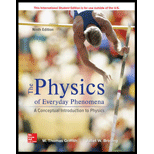
Concept explainers
(a)
The energy required to ionize a hydrogen atom in its lowest energy level.
(a)
Answer to Problem 3SP
The energy required to ionize a hydrogen atom in its lowest energy level is
Explanation of Solution
The energy level diagram of hydrogen proposed by the
Ionization energy is the energy required to remove an electron from its orbit. It will be equal to the negative of the energy of the electron in the orbit. The energy of the electron in the lowest level of hydrogen atom is
Conclusion:
Thus the energy required to ionize a hydrogen atom in its lowest energy level is
(b)
The energy required to ionize the hydrogen atom when it is in the first excited state above the lowest level.
(b)
Answer to Problem 3SP
The energy required to ionize the hydrogen atom when it is in the first excited state above the lowest level is
Explanation of Solution
The energy level diagram of hydrogen proposed by the Bohr model gives the energy of electrons in different orbits in hydrogen atom. The energy of a particular level in the hydrogen atom is given by the ratio of
The first excited state is the level which lies just above the ground level. The energy of the first excited state of hydrogen atom is
Ionization energy is the energy required to remove an electron from its orbit. It will be equal to the negative of the energy of the electron in the orbit. This implies the energy required to ionize the hydrogen atom in the first excited state will be equal to
Conclusion:
Thus the energy required to ionize the hydrogen atom when it is in the first excited state above the lowest level is
(c)
The wavelength of the photon emitted when an ionized hydrogen atom goes to the lowest energy level after capturing an electron with zero kinetic energy.
(c)
Answer to Problem 3SP
The wavelength of the photon emitted when an ionized hydrogen atom goes to the lowest energy level after capturing an electron with zero kinetic energy is
Explanation of Solution
An ionized hydrogen atom will have zero energy. The energy of the lowest level in the hydrogen atom is
Write the equation for the energy of the photon.
Here,
Substitute
Write the equation for the energy of a photon.
Here,
Rewrite the above equation for
The value of
Substitute
Conclusion:
Thus the wavelength of the photon emitted when an ionized hydrogen atom goes to the lowest energy level after capturing an electron with zero kinetic energy is
Want to see more full solutions like this?
Chapter 18 Solutions
Physics of Everyday Phenomena
- (a) What is the minimum value of 1 for a subshell that has 11 electrons in it? (b) If this subshell is in the n=5 shell, what is the spectroscopic notation for this atom?arrow_forwardHow do the allowed orbits for electrons in atoms differ from the allowed orbits for planets around the sun? Explain how the correspondence principle applies here.arrow_forward(a) If one subshell of an atom has 9 electrons in it, what is the minimum value of l ? (b) What is the spectroscopic notation for this atom, if this subshell is part of the n=3 shell?arrow_forward
- (a) How many electrons can be in the n=4 shell? (b) What are its subshells, and how many electrons can be in each?arrow_forwardHow do the allowed orbits for electrons in atoms differ from the allowed orbits for planets around the sun? Explain how the correspondence principle applies here.arrow_forwardA hydrogen atom in an excited state can be ionized with less energy than when it is in its ground state. What is n for a hydrogen atom if 0.850 eV of energy can ionize it?arrow_forward
- What two pieces of evidence allowed the first calculation of me, the mass of the electron? (a) The ratios qe/me and qp/mp. (b) The values of qe and EB. (c) The ratio qe/me and qe. Justify your response.arrow_forwardAn atom can be formed when a negative muon is captured by a proton. The muon has the same charge as the electron and a mass 207 times that of the electron. Calculate the frequency of the photon emitted when this atom makes the transition from n=2 to the n=1 state. Assume that the muon is orbiting a stationary proton.arrow_forward(a) What is the momentum of a 0.0100-nm-wavelength photon that could detect details of an atom? (b) What is its energy in MeV?arrow_forward
- What is the difference in energy between the nx=ny=nz=4 state and the state with the next higher energy? What is the percentage change in the energy between the nx=ny=nz=4 state and the state with the next higher energy? (b) Compare these with the difference in energy and the percentage change in the energy between the nx=ny=nz=400 state and the state with the next higher energy.arrow_forward(a) Calculate the velocity of an electron that has a wavelength of 1.00 m. (b) Through what voltage must the electron be accelerated to have this velocity?arrow_forward4. A proton and an electron recombine to form atomic hydrogen in its 4p state. At what wavelengths will recombination lines be observed? Label each wavelength by its standard series notation. How would the observed emissions differ if the atoms had recombined to the 4s level? (This means that the initial state is the 4p state. Determine all possible transition where a photon is emitted after the formation of the 4p state including cascading transitions. Apply selection rules)arrow_forward
 Glencoe Physics: Principles and Problems, Student...PhysicsISBN:9780078807213Author:Paul W. ZitzewitzPublisher:Glencoe/McGraw-Hill
Glencoe Physics: Principles and Problems, Student...PhysicsISBN:9780078807213Author:Paul W. ZitzewitzPublisher:Glencoe/McGraw-Hill College PhysicsPhysicsISBN:9781285737027Author:Raymond A. Serway, Chris VuillePublisher:Cengage Learning
College PhysicsPhysicsISBN:9781285737027Author:Raymond A. Serway, Chris VuillePublisher:Cengage Learning
 University Physics Volume 3PhysicsISBN:9781938168185Author:William Moebs, Jeff SannyPublisher:OpenStax
University Physics Volume 3PhysicsISBN:9781938168185Author:William Moebs, Jeff SannyPublisher:OpenStax College PhysicsPhysicsISBN:9781938168000Author:Paul Peter Urone, Roger HinrichsPublisher:OpenStax College
College PhysicsPhysicsISBN:9781938168000Author:Paul Peter Urone, Roger HinrichsPublisher:OpenStax College




